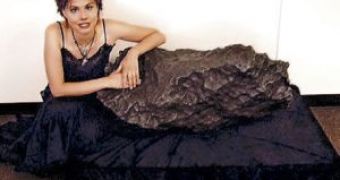A trip to Mars would last for at least 6 months during which the spaceship would be bombarded by the radiation coming from the Sun. On Earth we are protected from this radiation by the planet's magnetic field, but once in the interplanetary space, the ship will be devoid of such protection. The astronauts would face the danger of developing cancer and other serious medical problems.
"The biggest obstacle facing manned space exploration is the threat of biologically hazardous cosmic radiation," Daniella Della-Giustina said. "If we don't develop an effective solution to this issue, the threat of cosmic radiation will prevent a manned mission to Mars."
Della-Giustina, an engineering physics undergrad from the University of Arizona, has now won a $9,000 NASA Institute for Advanced Concepts (NIAC) Student Fellows Prize for her project of using asteroid as shields against radiation. The idea was initially proposed by science-fiction writer Arthur C. Clark in a short story called Summertime.
"Everything had been carefully planned, years in advance, as part of the International Astrophysical Decade," Clark wrote. "Here was a unique opportunity for a research ship to get within a mere seventeen million miles of the Sun, protected from it's fury by a two-mile-thick shield of rock and iron. In the shadow of Icarus, the ship could ride safely round the central fire which warmed all the planets, and upon which the existence of all life depended."
Della-Giustina's project, titled "The Martian Bus Schedule: An Innovative Technique for Protecting Humans on a Journey to Mars", is to use asteroids either as shields or maybe even as vehicles.
There are many asteroids crossing the orbits of both Earth and Mars. The point is to fly to one of these when they are near Earth and then wait there until they reach the neighborhood of Mars. The asteroid could be used not only as a shield against radiation but could also be mined for useful resources such as water.
The other possibility is to use the asteroid just as an umbrella rather then like a bus and to stay in its shadow for as long as possible. Even so, the astronauts could still do space-walks to gather resources from the rock.
This isn't the first time NASA investigates ideas put forward by science-fiction writers. Another idea for radiation shielding was proposed in the 1930s by John W. Campbell. In The Ultimate Weapon Campbell wrote:
"You mean they bathed that ship in neutrons?" "Shot it full of 'em. Just like our proton guns, only sending neutrons." "Well, why weren't we killed too?" "Water stops neutrons," Kendall said. "Figure it out." "The rocket-water tanks - all around us... that saved us?"
Richard Wilkins, director of NASA's Center for Applied Radiation Research at Prairie View A & M University in Texas picked up the idea and investigated whether one could use the liquid hydrogen tanks as shield against solar radiation.
"In most scenarios, you need liquid hydrogen for fuel and you need water," he said. "And these are all considered materials that are particularly good for cosmic ray shielding."
He discovered that liquid hydrogen not only provides an excellent screen against cosmic rays - the hydrogen atoms also don't fragment into secondary particles. Other proposals for shields, such as the use of lead, have this problem and the radiation from the secondary particles can be just as harmful as that from the Sun.
The two ideas could be combined to minimize both the amount of material the space-ship needs to carry from Earth and the amount of radiation experienced by the astronauts.
Della-Giustina plans to use her fellowship funds to make direct observations of near-Earth asteroids. Moreover, she will travel to Denver to collaborate with Lockheed Martin researchers and will conduct cosmochemistry experiments at University of Arizona. These experiments should determine whether the soil or dust materials (called regolith) on an asteroid could really offer the protection.
"There have been ideas tossed around about using lunar regolith to shield astronauts on the moon," she explained. "It's high in hydrogen content, and we think it could help shield cosmic radiation and solar radiation. It depends on the chemical content of the material. That's part of my proposal, to find the exact chemical composition, then expose it to radiation to see how effective it would be."
"All the current systems proposed for shielding cosmic radiation have kind of been yielded infeasible," she added. "They are either too heavy to launch into space or they are inefficient in an area that could potentially harm humans."

 14 DAY TRIAL //
14 DAY TRIAL //